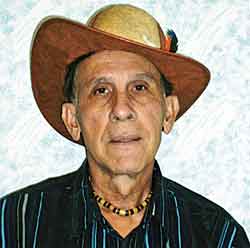November 2, 2011 issue
Arts & Entertainment
Choice of biscuits were 'Admirals'
or 'Brukmouth'

Bernard Heydorn
How many of you folks remember the biscuits (crackers/cookies) we ate when we were children, growing up in Guyana? I am a "biscuit man" and a night does not go by without me eating my biscuits washed down with a glass of milk, before I go to bed.
British Guiana's first biscuit factory was reportedly the Demerara Biscuit Factory in Georgetown. The proprietors were Wieting and Richter (the Ice House) on the west side of Water Street as you go north toward the railway tracks. Wieting and Richter, established

Edger Boy biscuits were also made by the B.G. Biscuit Factory, 34 – 35 High Street, Georgetown, (High and Leopold Streets). The company was Managed and Directed by Carlos Fernandes. In information given to me by Carlos Fernandes' son, Carlos Fernandes Jr; who lives in Canada, the Company operated between the 1920's and the 1960's. In addition to Edger Boy biscuits, they also sold cream (sweet) biscuits to shops and merchants around Guyana The biscuits were also supplied to the schools (school feeding program) and the prisons.
Later the Continental Biscuit Factory came along and also, I believe, sold Edger Boy biscuits. Edger Boy biscuits are sometimes confused with Break O' Day biscuit, a salt cracker. Why the biscuit was called Break O' Day I do not know, except for the fact that it was probably eaten at the break of each day. Salt biscuits were also popular with Guyanese pork-knockers who packed them in their knapsacks before they set off to pan for gold in the Interior of the country.
Other popular biscuits were Sadler's sweet biscuit, baked at Sadler's Bakery on Crown and Albert Streets in Queenstown, Georgetown. Sadler's Biscuit was over four inches in diameter, thick and sweet, big enough to be a meal for a small boy, and sold for a cent in the 1940's.
Other well known biscuits were aniseed biscuits (flavoured with aniseed), and "brukmouth", so hard it could break your rotting and even good teeth! There were also coconut biscuits, crackers, cracknel, and record biscuits.
I remember eating round sweet biscuits made by the Continental Biscuit Factory in Georgetown and washing them down with a bottle of pasteurized milk at a cake-shop, after a ride on the Seawall in the 50's and 60's. They were sold across the counter loosely and cheaply from an opened can.
A special treat for me as a boy in Guyana was imported tea biscuits from England. Two well known brands were Peek Frean and Huntley and Palmer, These tea biscuits included ginger snaps, short bread, cream sandwich biscuits and Marie biscuits. Wafers with cream in-between which we called "mouth organ" biscuits were my favourite.
Marie biscuits were my mother's favourite. We saw these imported biscuits once a year at Christmas time in our household. My father would buy a tin of assorted biscuits and bring it out on Christmas day. We were then allowed to eat one or two, as they were strictly rationed.
The empty, round, tin cans, were later used as storage containers for Christmas sponge and black cakes. We did not have a refrigerator in our house. The larger, square tin can, was used as a bread can (bin) to store our bread. That can sat on the dining room table all day long. We, as children, could only open it at meal time. Sad to say, at some times it was empty!
I have an old, faded picture with the bread can on the dining table in the background at our house in King Street in New Amsterdam in the 1950's. This was a haunted house and at night we could hear the "jumbies" (spirits) throwing things around, but fortunately for us, they never got into the bread can.
Marie biscuit, made by Peek Frean, is still available today. It's a plain, kind of sweet, round biscuit, with its name engraved in the top surface. Marie biscuits were very popular and exported around the world. Their flavour made them suitable for drinking with milk and tea. The Marie biscuit was made by the English Bakery, Peek Frean in London, England in 1874, to commemorate the marriage of the Grand Duchess of Russia to the then Duke of Edinburgh. The Peek Frean Company always had on their biscuit cans the inscription, "by appointment to Her Majesty the Queen".
Salt biscuits could be eaten with butter, peanut butter, jam, guava jelly, cheese or "fresh tongue" (nothing on it). There were two kinds of butter – imported table butter which the well-to do could afford, and locally made salt butter. This butter was a kind of reddish butter that often went rancid.
Now that I have given you some biscuits to think about, go and chew on them. If the creeks don't rise and the sun still shines I'll be talking to you.